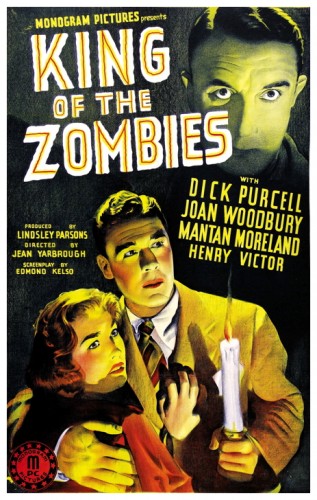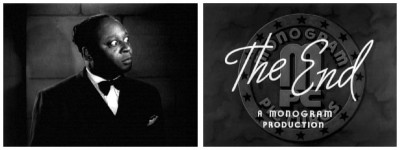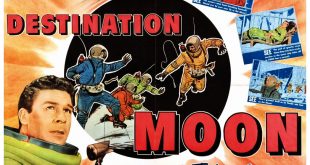“During World War Two, a small plane off the south coast of America is low on fuel and blown off course by a storm. Guided by a faint radio signal, they crashland on an island. The passenger, his manservant and the pilot take refuge in a mansion owned by a doctor. The easily-spooked manservant soon becomes convinced the mansion is haunted by zombies and ghosts. Exploring, the three find a voodoo ritual in the cellar, where the doctor is trying to acquire war intelligence by transferring personalities into his zombies. But the interruption causes the zombies to turn on their creator.” (courtesy IMDB)
REVIEW:
Zombies! I simply can’t get enough of them, especially from the thirties and forties. Stick in a handful of zombies, and I have very few complaints. As a matter of fact, I’m one of the few people that still seems to enjoy traditional voodoo zombie movies – which are few and far between – just as much as recent infected zombie movies. King Of The Zombies (1941) is one such movie, the first zombie-comedy ever made and, even after all these years, it’s still one of the best. It remains – get it? – it remains the only zombie movie ever to be nominated for an Oscar, and I’m confident you’ll feel it’s ninety minutes of time well-spent.
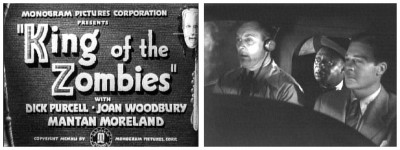 But I must reiterate that these zombies are not the flesh-eating kind. In earlier decades, zombies were the traditional voodoo kind like in White Zombie (1932), but George Romero changed the rules in the sixties with The Night Of The Living Dead (1968) and, ever since then, old school voodoo zombies have become a dying species – or should that be ‘undying species’? Directed by prolific filmmaker Jean Yarbrough, King Of The Zombies became a major inspiration for reluctant ghost-chasers from Abbott & Costello to Shaggy & Scooby Doo, and is also one of the first ever Blaxploitation films, so turn the Political Correctness dial on your television all the way up to ‘ouch!’ as Mantan Moreland, Dick Purcell, John Archer, Joan Woodbury and Henry Victor are granted an audience with…the King Of The Zombies!
But I must reiterate that these zombies are not the flesh-eating kind. In earlier decades, zombies were the traditional voodoo kind like in White Zombie (1932), but George Romero changed the rules in the sixties with The Night Of The Living Dead (1968) and, ever since then, old school voodoo zombies have become a dying species – or should that be ‘undying species’? Directed by prolific filmmaker Jean Yarbrough, King Of The Zombies became a major inspiration for reluctant ghost-chasers from Abbott & Costello to Shaggy & Scooby Doo, and is also one of the first ever Blaxploitation films, so turn the Political Correctness dial on your television all the way up to ‘ouch!’ as Mantan Moreland, Dick Purcell, John Archer, Joan Woodbury and Henry Victor are granted an audience with…the King Of The Zombies!
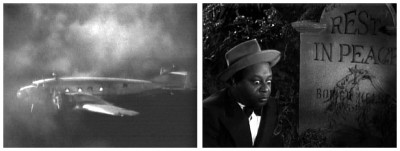 A tiny model plane carrying three men (how they all fit in there I’ll never know) crash-lands on a tiny model of a Caribbean island. The pilot (John Archer), his passenger (Dick Purcell) and his comic relief (Mantan Moreland) take refuge in an isolated mansion owned by a mysterious German doctor (Henry Victor). It may sound like the beginning of The Human Centipede IV, but it’s no-where near that tasteful. The quick-witted but easily-spooked comic relief is convinced the mansion is haunted by zombies, and spends the rest of the film trying to convince people of what he saw. A bit like Big Bird’s initial problem with Mr. Snuffleuppagus on Sesame Street, which just so happened to coincide with a spike in the number of nervous breakdowns experienced by children under the age of six.
A tiny model plane carrying three men (how they all fit in there I’ll never know) crash-lands on a tiny model of a Caribbean island. The pilot (John Archer), his passenger (Dick Purcell) and his comic relief (Mantan Moreland) take refuge in an isolated mansion owned by a mysterious German doctor (Henry Victor). It may sound like the beginning of The Human Centipede IV, but it’s no-where near that tasteful. The quick-witted but easily-spooked comic relief is convinced the mansion is haunted by zombies, and spends the rest of the film trying to convince people of what he saw. A bit like Big Bird’s initial problem with Mr. Snuffleuppagus on Sesame Street, which just so happened to coincide with a spike in the number of nervous breakdowns experienced by children under the age of six.
 Earlier I eluded to the fact that this is the only horror comedy to be nominated for an Academy Award, going to prolific composer Edward Kay for his rather repetitive soundtrack, from which I can only conclude that 1941 must have been Anus Horribilus for movie music. Sadly, after an amazing 335 titles as musical director, this week’s film is the best of a very mediocre bunch, which includes Navy Secrets (1939), Wolf Call (1939), The Ape (1943), Mister Muggs Rides Again (1945), Freddie Steps Out (1946), and Gentleman Joe Palooka (1946), finishing his three-decade crime-wave with The Creation Of The Humanoids (1962) which was, of course, remade as the cult film Blade Runner (1982), except with Harrison Ford and boobs.
Earlier I eluded to the fact that this is the only horror comedy to be nominated for an Academy Award, going to prolific composer Edward Kay for his rather repetitive soundtrack, from which I can only conclude that 1941 must have been Anus Horribilus for movie music. Sadly, after an amazing 335 titles as musical director, this week’s film is the best of a very mediocre bunch, which includes Navy Secrets (1939), Wolf Call (1939), The Ape (1943), Mister Muggs Rides Again (1945), Freddie Steps Out (1946), and Gentleman Joe Palooka (1946), finishing his three-decade crime-wave with The Creation Of The Humanoids (1962) which was, of course, remade as the cult film Blade Runner (1982), except with Harrison Ford and boobs.
 King Of The Zombies was also the career high point for director Jean Yarbrough, whose previous effort was The Devil Bat (1940) starring Bela Lugosi and followed through with House Of Horrors (1946), She-Wolf Of London (1946), The Creeper (1948) and, the final brick in his tomb, the self-explanatory Hillbillies In A Haunted House (1967). Proving once again that white men can’t jump – or spot a zombie from two metres away – is Dick Purcell. He gained fame as the first Captain America (1944), which was the most expensive and therefore the last of the Republic serials. It was also the last of Dick Purcell, who had the remarkably poor timing to pass away just before the serial was released to enormous success.
King Of The Zombies was also the career high point for director Jean Yarbrough, whose previous effort was The Devil Bat (1940) starring Bela Lugosi and followed through with House Of Horrors (1946), She-Wolf Of London (1946), The Creeper (1948) and, the final brick in his tomb, the self-explanatory Hillbillies In A Haunted House (1967). Proving once again that white men can’t jump – or spot a zombie from two metres away – is Dick Purcell. He gained fame as the first Captain America (1944), which was the most expensive and therefore the last of the Republic serials. It was also the last of Dick Purcell, who had the remarkably poor timing to pass away just before the serial was released to enormous success.
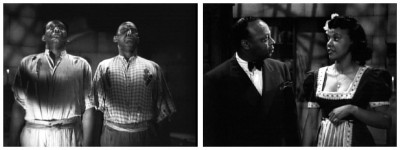 I dare say you’ve thought more than once tonight that Bill the pilot has a great face for radio – and you’d be right! John Archer‘s most famous role was as Lamont Cranston aka The Shadow in the late thirties, which was apparently streamed live every week on a primitive analog wireless connection. He had a few small roles in films like White Heat (1949), Destination Moon (1950), Rock Around The Clock (1956), Blue Hawaii (1961) and How To Frame A Figg (1971), but made most of his money appearing in a gazillion television shows like The Millionaire, Sea Hunt, Maverick, The Twilight Zone, Surfside Six, 77 Sunset Strip, Wagon Train, Hawaiian Eye, McHales Navy, Perry Mason, Bonanza, Mannix and The Name Of The Game.
I dare say you’ve thought more than once tonight that Bill the pilot has a great face for radio – and you’d be right! John Archer‘s most famous role was as Lamont Cranston aka The Shadow in the late thirties, which was apparently streamed live every week on a primitive analog wireless connection. He had a few small roles in films like White Heat (1949), Destination Moon (1950), Rock Around The Clock (1956), Blue Hawaii (1961) and How To Frame A Figg (1971), but made most of his money appearing in a gazillion television shows like The Millionaire, Sea Hunt, Maverick, The Twilight Zone, Surfside Six, 77 Sunset Strip, Wagon Train, Hawaiian Eye, McHales Navy, Perry Mason, Bonanza, Mannix and The Name Of The Game.
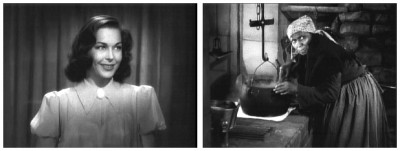 Young Barbara is played by Joan Woodbury, who kick-started her career by appearing in no less than twenty-three films between 1934 and 1936. She appeared in fifty more films over the next decade, displaying her amazing acting talent by tolerating singing cowboys like Hopalong Cassidy and Roy Rogers, leading up to her most famous role as Brenda Starr Reporter (1945). Then, at the height of career, she retired from the acting game to follow the American Dream, and married a Hollywood producer – that always works out. She kept her foot in the water so-to-speak, with appearances in both The Time Travelers (1964) and Cecil B. DeMille‘s The Ten Commandments (1956). A mix of Danish, British and Native American heritages, Joan developed a reputation behind-the-scenes for arguing with herself when drunk.
Young Barbara is played by Joan Woodbury, who kick-started her career by appearing in no less than twenty-three films between 1934 and 1936. She appeared in fifty more films over the next decade, displaying her amazing acting talent by tolerating singing cowboys like Hopalong Cassidy and Roy Rogers, leading up to her most famous role as Brenda Starr Reporter (1945). Then, at the height of career, she retired from the acting game to follow the American Dream, and married a Hollywood producer – that always works out. She kept her foot in the water so-to-speak, with appearances in both The Time Travelers (1964) and Cecil B. DeMille‘s The Ten Commandments (1956). A mix of Danish, British and Native American heritages, Joan developed a reputation behind-the-scenes for arguing with herself when drunk.
 Speaking of imbibing, the role of Doctor Sangre was intended for Bela Lugosi, but he was beginning to experiment with controlled substances at that time. Peter Lorre was approached, but he was experimenting with enormous appearance fees at that time. Finally, at the last minute, character actor Henry Victor was signed up, as he was neither stoned nor expensive. Born in England but raised in Germany, Victor is probably best remembered as the stupid strongman Hercules in Tod Browning‘s classic film Freaks (1932), after which he was typecast as villains and Nazis on both sides of the Atlantic with his trademark German accent.
Speaking of imbibing, the role of Doctor Sangre was intended for Bela Lugosi, but he was beginning to experiment with controlled substances at that time. Peter Lorre was approached, but he was experimenting with enormous appearance fees at that time. Finally, at the last minute, character actor Henry Victor was signed up, as he was neither stoned nor expensive. Born in England but raised in Germany, Victor is probably best remembered as the stupid strongman Hercules in Tod Browning‘s classic film Freaks (1932), after which he was typecast as villains and Nazis on both sides of the Atlantic with his trademark German accent.
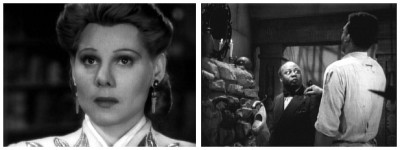 The most prestigious name attached to King Of The Zombies is Madame Sul-Te-Wan, who plays the cook and high priestess. She could be seen in the silent epics Birth Of A Nation (1915) and Intolerance (1916), and could also be heard in many high-profile talkies alongside some of the best talent in Hollywood: Barbara Stanwyck, Fay Wray, Jane Wyman, Melvyn Douglas, Lucille Ball, Veronica Lake, Claudette Colbert and King Kong (1933). Sadly, segregation limited her to minor characters such as convicts, natives or servants, nevertheless her career spanned over five decades. She was the first African-American actor ever to sign a Hollywood contract, and was duly inducted into the Black Filmmakers Hall Of Fame in 1986.
The most prestigious name attached to King Of The Zombies is Madame Sul-Te-Wan, who plays the cook and high priestess. She could be seen in the silent epics Birth Of A Nation (1915) and Intolerance (1916), and could also be heard in many high-profile talkies alongside some of the best talent in Hollywood: Barbara Stanwyck, Fay Wray, Jane Wyman, Melvyn Douglas, Lucille Ball, Veronica Lake, Claudette Colbert and King Kong (1933). Sadly, segregation limited her to minor characters such as convicts, natives or servants, nevertheless her career spanned over five decades. She was the first African-American actor ever to sign a Hollywood contract, and was duly inducted into the Black Filmmakers Hall Of Fame in 1986.
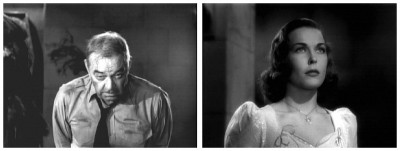 But the real star of King Of The Zombies is Mantan Moreland as the excitable Jefferson Jackson. By the late twenties Mantan had survived vaudeville, and began appearing in low-budget blaxploitation movies but, as his comedic talents came to be recognised, he scored smaller roles in much larger productions. He’s probably best known as the chauffeur in the Charlie Chan (1944) films, but my regular readers will probably remember him in his final film role ever, as the postman and first victim of Spider Baby (1968) in the film of the same name. Would you believe Mantan was actually considered as a possible addition to The Three Stooges after Shemp Howard passed away in 1955? Speaking of disasters averted, let’s get back to the second half of King Of The Zombies before I say something I regret about replacing Shemp with a shemp. Oops, too late.
But the real star of King Of The Zombies is Mantan Moreland as the excitable Jefferson Jackson. By the late twenties Mantan had survived vaudeville, and began appearing in low-budget blaxploitation movies but, as his comedic talents came to be recognised, he scored smaller roles in much larger productions. He’s probably best known as the chauffeur in the Charlie Chan (1944) films, but my regular readers will probably remember him in his final film role ever, as the postman and first victim of Spider Baby (1968) in the film of the same name. Would you believe Mantan was actually considered as a possible addition to The Three Stooges after Shemp Howard passed away in 1955? Speaking of disasters averted, let’s get back to the second half of King Of The Zombies before I say something I regret about replacing Shemp with a shemp. Oops, too late.
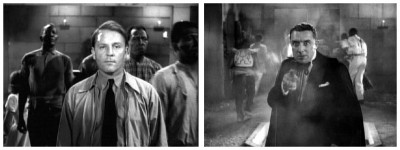 SPOILER ALERT! Being shot with bullets turns zombies back into normal human beings! How times have changed – these days they shrug off anything but a head shot and still keep coming. And keep an eye out (ow!) for my cameo too. You can always liven up a library with some curtains, a few throw-pillows and a human skull or two – or so I read in Better Homes & Graveyards – or should that be ‘Marble Orchards’? Produced mere months before Japan’s attack on Pearl Harbour, King Of The Zombies manages to avoid any blatant references to Nazi Germany, though the villain is a German who broadcasts in German. There’s a good reason for this: Monogram had problems a couple of years earlier when they tried to release Hitler The Beast Of Berlin (1939) in Berlin – the film failed to pass European censorship boards and almost bankrupted the studio.
SPOILER ALERT! Being shot with bullets turns zombies back into normal human beings! How times have changed – these days they shrug off anything but a head shot and still keep coming. And keep an eye out (ow!) for my cameo too. You can always liven up a library with some curtains, a few throw-pillows and a human skull or two – or so I read in Better Homes & Graveyards – or should that be ‘Marble Orchards’? Produced mere months before Japan’s attack on Pearl Harbour, King Of The Zombies manages to avoid any blatant references to Nazi Germany, though the villain is a German who broadcasts in German. There’s a good reason for this: Monogram had problems a couple of years earlier when they tried to release Hitler The Beast Of Berlin (1939) in Berlin – the film failed to pass European censorship boards and almost bankrupted the studio.
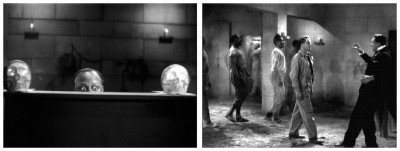 In what would otherwise be a rather mediocre movie, the hilarious performance of Mantan Moreland is masterful to say the least. It’s interesting to see that, even back in the forties, black people were the voice of reason in horror movies. White people never listen, and are therefore doomed. Before you have time to digest that crummy nugget of knowledge from a special source, I’ll quickly say my goodbyes and disappear into the night, but not before inviting you to return next week to sacrifice another ninety minutes of your precious life to witness dark depravities never before realised – well, almost never – with…Horror News! Toodles!
In what would otherwise be a rather mediocre movie, the hilarious performance of Mantan Moreland is masterful to say the least. It’s interesting to see that, even back in the forties, black people were the voice of reason in horror movies. White people never listen, and are therefore doomed. Before you have time to digest that crummy nugget of knowledge from a special source, I’ll quickly say my goodbyes and disappear into the night, but not before inviting you to return next week to sacrifice another ninety minutes of your precious life to witness dark depravities never before realised – well, almost never – with…Horror News! Toodles!
 Horror News | HNN Official Site | Horror Movies,Trailers, Reviews
Horror News | HNN Official Site | Horror Movies,Trailers, Reviews
